
Five o’clock-tea – what could be better?
The best thing about England is the Five o’clock-tea
It comprehends a big pot of tea, black tea of course, but it may also be flavoured, for example Earl-Grey, and small appetizers. Where small is often not really true. Actually, it could replace a meal. And the time is also very variable. You can get scones in the morning as well.
History of the Five o’clock-tea
There are several stories about the emergence of the Five o’clock-tea, one is, for example, that at five o’clock something was eaten and drunk, so that at dinner no unpleasant stomach sounds would be heard. Tea was not introduced to England until the mid-17th century. Drinking tea, however, was reserved exclusively to the high society, as it was very expensive, on one hand because it came from far away and on the other hand because it was heavily taxed. Only when the tea taxes were lowered towards the end of the 17th century the middle and the poorer class could afford it.
The only question left is whether the milk or the tea comes into the cup first
This question divides the tea drinkers into two groups. Originally, the milk was poured into the cup first, since the fine porcelain tableware could not stand the heat of the tea. Nowadays, this danger no longer exists, but many cling to this tradition. There is no final solution, just try it and do whatever you prefer…
With a classic Five o’clock-tea there needs to be an Etagère
Which is a rack with 3 plates one above the other. On each plate a typical appetizer is served and you eat them, from bottom to top. There is something salty on the bottom plate. Small sandwiches, topped with cucumber, egg or salmon. The scones are on the middle plate, served with clotted cream and strawberry jam. And on the top plate there are cookies and cake.
What are scones?
Scones are small buns, very lightly sweetened and very easy to make. You do not need yeast, but baking powder and therefore they do not have to rise as dough, but only in the oven. Traditionally, they are neutral or with raisins in it. In Australia I also ate a variant with Lemonmyrtle. They were delicious and lemony-fresh. However, Lemonmyrtle is almost unavailable in Europe. You should taste it on your next trip to Australia. To eat, scones are then divided in the middle and coated with clotted cream and strawberry jam.

What is Clotted cream?
Actually it’s something very simple: thickened cream. You can only buy it in shops that also offer English specialties, or you can order it (unfortunately not in Switzerland) You can also make yourself at home.

Make clotted cream yourself
You only need full-fat cream. You should fill about 5 cm of cream it into a baking dish, which is then placed in the pre-heated oven at 70°C for 12 hours. After 12 hours you can take it out of the oven and let it cool down. After cooling down, you have to cover the casserole with plastic wrap and place it in the refrigerator for 12 hours, then it’s finally done. Now you can carefully scoop the clotted cream from the top, while below there is the liquid part which you can use for baking or cooking.
Scones with clotted cream are of course a dream, but if you like them a little easier to digest, you can also eat them with crème fraîche.
So here’s the recipe for the scones:
Ingredients for about 10 pieces:
- 225 g flour
- 1 tsp baking powder
- 1 Tbsp sugar
- ½ tsp salt
- 50 g butter at room temperature
- Yogurt or crème fraîche, as much as necessary
- 1 tsp raisins (optional)
Preparation:
Preheat the oven to 200°C. Mix the first 5 ingredients, then gradually add enough yogurt or crème fraîche until a soft, malleable dough is formed.
Then roll out the dough onto some flour, it should be about 2 cm thick. With the help of a round cookie cutter (diameter 5 cm, a small drinking glass also works), cut out scones. Place the dough circles on a tray lined with a baking sheet and bake them at 200°C for 10 to 15 minutes.



They are best eaten the same day you made them?
Next week I’ll write about ginger





